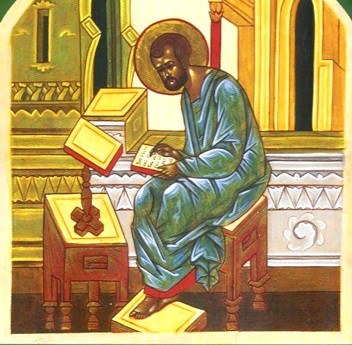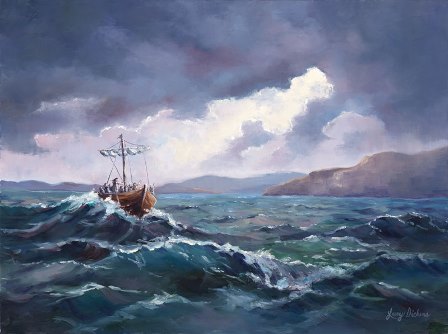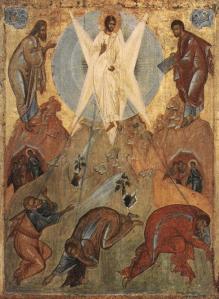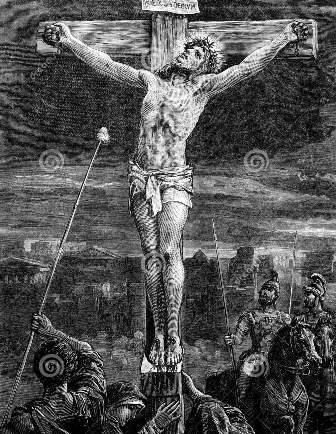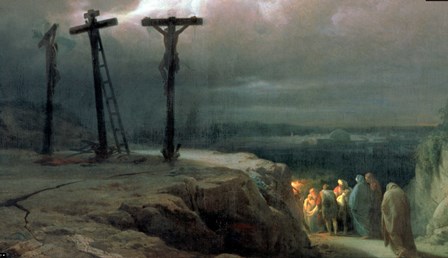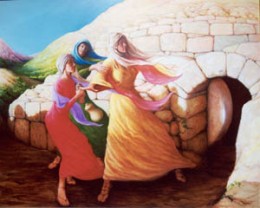THE MARCAN GOSPEL
AND
THE EARLY CHRISTIANS IN ROME
(given at a Lenten Quiet Day, 2015)
Every third year (cycle B) the Gospel is pronounced from the Markan one. I am discussing firstly how I think we have this gospel and secondly how it shaped its content. Before I do that, it is important to realise that each gospel came from a different community and is a reflection of what was happening and being taught in the respective communities.
Let me take you back towards the end of the sixties in the first century A.D. during the reign of Nero in Rome where I think this gospel was written. By now Christians were numerous enough to be distinguished from the Jews who also lived in Rome in great numbers.
We are not sure how the Gospel came to the eternal city, it certainly was not brought by either Peter or Paul. We do now around A.D. 49 some followers of Chrestus, including Aquila and Prisca whom we meet in Paul’s letters, had been expelled from Rome under Claudius and were in Corinth when Paul first visited c.51.
In c. A.D. 64 a great fire engulfed Rome. Only four of the eighteen districts were untouched. Amongst those districts untouched was the Jewish quarter. Someone had to be responsible and made accountable. It seems Nero himself was responsible but of course others would have to be a scapegoat. Even though their quarter was not burned, Nero never picked on the Jews. Instead, he picked on the Christians. They were blamed for it and rounded up. It is believed that Peter and Paul both were martyred during this persecution, although there is no record of where they were martyred. With them, many Christians died horribly and many lived in fear of persecution, torture and death.
However, from the earliest evidence we have, it would seem that some Christians died, including Peter and Paul, because Christians pimped on one another. The presbyter, Clement, writing c. 95 indicates that even these two great disciples had died because of “jealous zeal and envy” (Ch.4). Who hated these two so much and other Christians? It seems they were the most conservatives of all the early Christians groups, some amongst the Jewish Christians, who insisted on circumcision. Paul had earlier confronted these Christians in Galatia c.50. When you read this letter, you discover a Paul who is angry, very angry at what these very conservative Jewish Christians had done - torn apart the Christian community he had left behind.
Others apostasied to save their lives. This meant that when tested they had denied Christ as their Lord. They had failed Him miserably when put to the test. What would become of the Roman Christian community? Would it survive?
Knowing all this the evangelist of the first Gospel decided to put pen to paper for a couple of reasons. One was the great leaders and preachers were dead and Christ’s teaching had to be preserved; another was to encourage the surviving Christians in their faith. The overall meaning of his gospel is one of human failure by those chosen by Jesus to be His followers. But, out of that, God used this failure to do His work. So let us have a look at it.
We do not know who is the author. Some have suggested it is the Mark who is a companion of Paul and Barnabas and lived in Jerusalem. I do not think this is the author as he does not have a geographical knowledge of Palestine. For example after the feeding of the four thousand he describes Jesus returning to a village called Dalmuntha on the lake of Galilee. None has heard of such a place.
Some have thought that Mark was the scribe to Peter as recorded by Papias in the early 2nd C. If this were true, why does he not paint Peter in a better picture than he does as in Matthew’s gospel? So to be honest we really do not know.
What we also do not know whether there had been an attempt to write down any of our
Lord’s teaching beforehand and the evangelist had access to it. There must have been various Christian traditions that had been passed on in the various centres. If this Gospel and Paul’s authentic letters are digested correctly, it would seem the main early traditions centred on the Passion, Death and then the Resurrection of Christ.
We do know from this gospel, the evangelist whom we know as Mark, is not well educated and the other Synoptic evangelists correct his mistakes when they use his gospel as the basis for theirs. Nevertheless, he was intent on writing “the Gospel of Jesus Christ, the Son of God” in such a way to be comforting to his fellow Christians in Rome. There is immediacy to it, seen in its fast moving with the number of times he uses the word “immediately” or “straightway” in connection with what Jesus does and says.
As we begin reading this Gospel the evangelist has told us, the reader, that Jesus Christ is the Son of God. We soon discover two things that demons know who Jesus is, and we the reader know more than the disciples. They continue not to understand and are complete failures. The reader has to wait until the end of the gospel for another human being to recognise who Jesus is. After his agonising suffering and death, a gentile, a centurion, utters, “truly this was the Son of God”. Why is this gospel so lacking in faith by the apostles and disciples? For example after Jesus calms the storm on the lake, Jesus says to them, “Why are you so fearful? How is it you have no faith?” (Mk.4.40).
The disciples are portrayed even being stupid as they repeatedly miss the point and Jesus has to take them aside and explain. For example after the feeding of the Four Thousand this is what we read:
And Jesus left them, and getting into the boat again he departed to the other side.
Now they had forgotten to bring bread; and they had only one loaf with them in the boat.
And he cautioned them, saying, "Take heed, beware of the leaven of the Pharisees and the leaven of Herod."
And they discussed it with one another, saying, "We have no bread."
And being aware of it, Jesus said to them, "Why do you discuss the fact that you have no bread? Do you not yet perceive or understand? Are your hearts hardened?
Having eyes do you not see, and having ears do you not hear? And do you not remember?
When I broke the five loaves for the five thousand, how many baskets full of broken pieces did you take up?" They said to him, "Twelve."
"And the seven for the four thousand, how many baskets full of broken pieces did you take up?" And they said to him, "Seven."
And he said to them, "Do you not yet understand?" (8.13-21).
Another example is after the Transfiguration when a father had brought his son to the disciples who stayed below the mount to be healed but they could not. The father had to wait until Jesus came down from the mountain. After healing the child, Jesus turned to the disciples and said, “O faithless generation, how long shall I be with you?” (9. 19).
The inner three on the Mount when they see Jesus being glorified still not see Him for what He is. One would think if nothing else could convince them, even though they had seen miracles such as Jesus walking on the water, the manifestation of Christ in glory would.
The lack of faith and the misunderstanding of the apostles is highlighted by this evangelist with the faith of Bartimæus who throws aside his cloak and yells out to the Son of David to heal his blindness. Afterwards he follows Jesus to Jerusalem and must have become a follower as this evangelist knew his name, Bartimæus. Throwing away his cloak indicates the beginning of a new life.
Another feature of this gospel is that it is full of secrets. Jesus did not want others to know Who He is. To the leper in the opening chapter, He commands him after being healed, not to tell anyone and is repeated throughout such as after raising Jarius’ daughter (5.43). Perhaps if you are going to stay alive during a time of persecution, don’t get into disputes. Stay low.
Yet another feature of the disciples is they are also portrayed being more concerned about power and wrangling amongst themselves than wanting to understand what Jesus is teaching them about His coming death and taking up the cross and following Him. In Ch.9. after our Lord had told them for the third time about His coming betrayal, suffering and death, on the way to Capernaum they were discussing who should be the greatest (9.34). They did not understand their Lord’s teaching on being child-like or a servant (10.13). They don’t understand what being a servant means, obvious when Peter says to our Lord, “we have left all to follow you” (10.28). Then we have the sons of Zebedee wanting to sit on either side of the Lord in the kingdom, followed by the anger of the others when they find out (10.37,41).
The reason for portraying the disciples as such suggests that if those whom Jesus had chosen had failed Him so miserably during the ministry, it was they who eventually went out and preached and brought the Gospel to cities like Rome.
However, the most important feature of the Marcan gospel is the evangelist’s account of the Passion and Death of Christ. It is absolutely stark and dark. There is only one positive statement by Jesus amongst all the negatives, “I shall go before you into Galilee” after telling the disciples they will all be scattered. Jesus suffers agonisingly and cries out to God in great distress, why he has been forsaken. He dies utterly alone.
A third of this gospel is taken up with the Passion. In many ways it looks as if the Gospel is the Passion with an introduction. As mentioned, it is this narrative that grabbed the imagination and narrating of those first Christians.
In contrast to what goes before, the Marcan Passion is thoroughly planned and is written in specific detail for each day, with its emphasis on location and time. As we have a look at the four acts of the Passion narrative observe how Jesus becomes increasingly alone as He is repudiated by more and more groups and people. By the time He dies, He is utterly alone and abandoned.
1. Act. 1.Sc.1. It begins with Jesus and His disciples singing a hymn as they set out for the Mount of Olives and to the Garden of Gethsemane. On the way Jesus quotes from Zechariah, “I will smote the shepherd, and the sheep shall be scattered” (Zech.13.7). This quotation is interesting because the earliest tradition always associated the word “scattered” with a loss in faith. Another question arises, did Jesus quote the whole passage? After all, we know that after Christ’s ascension, the early Christians combed the O.T. for passages related to Christ’s death especially. If one looks at this passage, it concludes with the Shepherd tendering those who are scattered. In the Passion narrative this is replaced by that one positive statement, “I shall go before you into Galilee”.
Peter responds vehemently that even if everyone else fled, he would not. Our Lord quips, You, Peter will do worse, you will deny me. If Peter, the recognised leader of the apostles denies? What does this mean?
When Gethsemane is reached, Jesus asks His disciples to sit and pray, taking with him the inner three. He moves away from them. One of the most desolate scenes in scripture is when Jesus falls to the ground and prays to Abba. Note that the Marcan Passion begins in Aramaic and ends with it, when Jesus cries out Eloi, Eloi, lamasabachthani.
Before this, the evangelist tells us that when Jesus arrived in the garden “He began to be distressed and agitiated.” The Greek word for distressed, ekthambeisthai, means to be greatly distraught” that indicates a profound disarray, expressed physically before a terrifying event. The Greek word for agitated, ademomein, means to be troubled and it has at its root a sense of being separated from others, a situation that results in anguish. So, at the beginning the evangelist is telling us the absolute agony and abandonment of our Lord.
The prayer to His Father was, if possible to take this Cup from Him. Previously he had asked James and John could they drink of the Cup when they wanted to sit on either side of Him in the kingdom, and now Jesus Himself is pleading not to drink it. Yet, after much agony, finally He is able to be obedient to His Father – to do His will and drink the cup. Meanwhile the three have not joined Him in prayer. He has been left alone in His agonised spirit. On returning to the three in the midst of His praying, He tells them to pray, lest they too enter into temptation. Prayer as Jesus knew strengthens the spirit against the flesh that is weak. But the fact that the apostles could not pray with Him is another indication of Jesus being abandoned.
Having accepted the Father’s will, Jesus returns and tells His disciples to arise for the betrayer is at hand.
Actually, the author of the Hebrew letter summed up this situation so well:
In the days of his flesh, Jesus offered up prayers and supplications, with loud cries and tears, to him who was able to save him from death, and he was heard for his godly fear. Although he was a Son, he learned obedience through what he suffered; and being made perfect he became the source of eternal salvation to all who obey him, (5.7ff).
Act. 1. Sc. 2. The second scene in this act is the ARREST. The hour has come when the Son of Man is to be betrayed into the hands of sinners. Judas has arrived who in the Greek is the hander-over. In this Passion narrative “hand-over” weaves through it. Judas hands over Jesus to the police/soldiers who in turn hand Him over to the Jewish authorities who then hand Him over to Pilate and who will eventually hand Jesus over to the soldiers to be crucified.
Two events happen to which Jesus is silent and does not respond. 1. To the kiss of Judas 2. The cutting off an ear of a servant by a bystander. But, when arrested Jesus does respond. Have you come out to arrest me as if I were a bandit? Note that later we are told that Barabbas was a bandit who was involved in an insurrection.
Jesus informs them, after all I was with you daily in the temple when you could have arrested me. Still these things had to be to fulfil Scripture.
Then all forsook Him and fled, climaxed in a young man stepping out of his clothing and fleeing naked when about to be arrested. Here we should note very early in the gospel we are told that the disciples forsook all to follow Christ. Now all has been forsaken to abandon Jesus. His nakedness enforces ALL the disciples have abandoned the Lord.
Act. 2. The Trial before the Jewish authorities. It is interesting that this evangelist structures both this and the Roman trial similarly. Both are unfair according to the evangelist as they were during the Christian persecution under Nero. The Sanhedrin tried to have witnesses accuse Jesus but no two agreed, even the charge that Jesus had been heard to say He will destroy this temple made with hands and in three days I shall build another. To these charges, Jesus has said not anything. Then a direct question is put to Jesus, “Are you the Christ, the son of the blessed?” To this, Jesus breaks His silence and acknowledges. As He confesses who He is, Peter is denying this when asked three questions 1. Was he with Jesus? His answer is evasive. 2. He is accused of being a follower – denial 3. His speech is a give-away – vehement denial. Peter as the cock crowed twice has betrayed His Lord dreadfully by vehemently denying any connection at all with Jesus and flees.
However would this question had been asked by the High Priest? It sounds a bit like what was happening to Christians in the synagogue later. Perhaps the question may have simply been, “Are you the Messiah?” In answering, positive to this, then Jesus could be accused of being a false prophet that was punishable by death according to the Mosiac Law (Deut.13.18). But of course this prophecy will be fulfilled.
All members of the Sanhedrin, including Joseph of Arimathea, find Jesus guilty without any substantial evidence. The actual members of the Sanhedrin slap and abuse Him. Jesus has now been abandoned by the Jewish officials.
Act 3. Before the Roman authorities. This is very brief and we are given no idea where Pilate is when Jesus is handed over to him by the members of the Sanhedrin. Pilate seems to blurt out of nowhere, this question, “Are you the king of the Jews?” It would seem that this question had already become part of the Christian tradition as Jesus’ reply, “That is what you say.” The former was the only thing written about Jesus in His lifetime when Pilate had it inscribed above His cross. While with Pilate, it is interesting how the chief priests keep butting in and making accusations. Jesus is again remarkably silent.
This is followed by the remarkable statement that at this feast the governor released unto the people a prisoner whom they desired. We are told there is one, one called Barabbas who was a bandit and deserving death. The people nearby clamoured for him but Pilate suggested that he release the King of the Jews for he knew he was innocent of the charge brought against Him. With encouragement from the chief priests, the people protest that it is Barabbas they wanted released. Pilate asked, “What should I do with the one you call King of the Jews?”
Their reply is “Crucify Him.” And again, “Crucify Him” when Pilate makes another plea for Jesus. From the Marcan version it would seem that Pilate has Jesus crucified to satisfy the crowd.
Why this scene? There is no historical evidence that a Roman Governor did this at Passover or at any feast. And why Barabbas who is guilty of crime? By the way, his name means “son of the father.” Of course introducing Barabbas, it highlights how the innocent becomes a scapegoat. Jesus, the innocent, the righteous One, is condemned and killed. This account of Barabbas must have been a very early tradition as each evangelist uses it in his own way. The way this evangelist has used it, is saying that even Jesus died innocently and not the one really guilty. It would be a comfort for those who lost family under Nero’s persecution whilst the guilty escaped.
The final scene of this act is the soldiers leading Jesus back inside where the whole cohort continued the mockery by dressing Jesus in purple and placing a crown of thorns on his head and hailing Him as the King of the Jews. Then they smite and spit on Him. Their treatment was no better than that of the chief priests, elders and scribes. Afterwards Jesus was dressed in His own clothes to be led away to Golgotha. Jesus, the righteous One bore all this torture.
If Jesus could bear this torture, He was showing His early followers that it is possible to endure with faith.
Act 4. The actual crucifixion is very brief. The evangelist devotes more time to the people who were at Calvary and the actual time when the events took place. For example, we read at the third hour Jesus was crucified; at the sixth darkness covered the earth.
On the way to Golgotha, Jesus is not quite alone as Simon helps to carry his cross. It would seem he and his sons, Alexander and Rufus were Christians in Rome and known to the evangelist. By carrying the cross for Jesus, Simon is illustrating the main teaching of this Gospel, you cannot be a follower of Jesus unless you bear the cross. Suffering is inescapable.
The events at Golgotha. 1. When Jesus reaches the place of the skull He is offered wine with myrrh that Jesus refuses. 2. The casting of lots for Jesus’ gown, with an indirect reference to Ps. 22 18.
Now the time becomes important for this evangelist as shown in his arrangement.
At the 3rd hour (9.00 ) Jesus is crucified while the inscription that He is King of the Jews is placed above Him. With Him, two criminals are also crucified. This was to fulfil the Scriptural passage from one of the Suffering Servant passages, “He was numbered amongst the transgressors (Isa.53.12).This is followed by those present continuing the mockery. All of these mimic the accusations made about Jesus at the trial. So 1. the passers-by mock Him by shouting, you who could destroy the temple and rebuild it in three days, come down from the cross and save yourself. 2. The chief priests cry out, let Him who is the King of the Jews save Himself. 3. The criminals join in the reviling. Even they abandon Jesus.
At the 6th hour (noon) darkness covers the whole land until the 9th (3.00). If disciples and others have deserted our Lord, nature has not forgotten Him – darkness has descended to blot out this terrible deed. It cannot be clearly witnessed.
At the 9th hour (3.00) It is Jesus on the cross, all alone. It is agonising, nothing like the triumphant Jesus in the Johannine version. Jesus is depicted that everyone, even God has deserted Him as he cries out Eloi, Eloi, lamasbachthani, It is the only time in the Gospels that Jesus addresses His Father as God to reveal His estrangement. “Why have you abandoned me?” from the opening line of Psalm 22. It is the depth of human sorrow and abandonment.
Some of those present thought he was crying for Elijah and went and found a sponge soaked in vinegar and as it was offered to Jesus, the mockery continues,Let’s see if Elijah will come and help.” Oblivious of all this, Jesus offers a loud cry, and gave up His spirit. At that moment, it is the darkest and the most abandoning for the Righteous One. It is wrenching.
But God had not abandoned Him. He was there as He rents the veil in the Temple. What is this saying? It is God’s judgment. He reverses human judgment by vindicating the Righteous One. Evil has not won. What Jesus has taught is true. He is the Son of God
God has also moved the heart of the centurion who has watched Jesus dying on the cross. Through the agonising suffering of Jesus on the cross, he declares that Jesus is truly the Son of God. This is amazing, especially when in this Gospel, it is the first time that someone recognises Jesus as the Son of God, what the evangelist had told the reader in the opening chapter of his gospel.
This declaration at Golgotha is even more powerful as it is juxtaposed against all the mockery of the Jews and the abandonment of Jesus by everyone. It is the reversion by God.
In the time of persecution, many Christians must have thought that God had abandoned them and He was not with them in their torture and agony. But the end of the Passion says God is listening. He will reverse the suffering of the righteous.
It would take time for His followers to know this truth, even the disciples. What is so crystal clear is that one cannot be a follower of Christ without the cross as Jesus stated to all during His ministry:
And Jesus called to him the multitude with his disciples, and said to them, "If any man would come after me, let him deny himself and take up his cross and follow me” (8.34).
One must know my suffering and it is suffering that God enters. Paul also knew when in Philippians he wrote, “Let the mind of Christ Jesus be in you.
A poem I wrote quite a few years ago I think sums up the Marcan Passion.
The cross
A little word.
But on it
A mighty deed
Performed.
The blessed Jesu stoops
To surrender life
For the good of man
And for his salvation.
O my people
Do you know?
Do you ever think?
How gruesome it was!
How all alone it was!
Spend some time
Gazing,
Feeling the suffering
Mingled with love
Flowing from my heart.
This is your lot too
For to be my disciple
You cannot love
Without the spear-stab
Twisting your heart.
M.D.
Such an experience by the Lord would have been a comfort to those left behind after the great persecution and all those suffering from losing love ones condemned without any real trial. If our Lord was treated as such, surely they could be bear their trials for their Lord too.
In today’s world, we would say that Jesus’ rejection, betrayal, abandonment and death stands for all those thousands in a similar position throughout this world at present. Those who do not have a voice; those who are imprisoned without a trial or worse still shot or beheaded for simply believing in Christ.
The Passion is followed by the burial scene. Joseph, a member of the Sanhedrin, consented to Jesus’ guilt, approach Pilate to bury the body. We are told he is a seeker of the kingdom of God. We must not read into the Marcan account what we read in the Johannine account.
It would seem he is doing what any pious Jew would do - to take down the body and wrap it in a linen cloth for burial. It is a simple burial. The women are looking on. If Joseph had been a follower, the women would have known and helped I am sure.
If the passion is desolate so is the ending of the original Gospel. Even the women who have been more faithful than the men and were there at Calvary, end up in terror and fear. When they go to the tomb, they find the rock rolled away and an angelic young man in white in the tomb. Remember the young man who fled in abandonment, the evangelist now portrays him restored. He tells the women not to be afraid. See He is risen. Go now and tells His disciples and Peter that Jesus goes before them into Galilee as He told them. However, the women did not deliver this message. They left the tomb quickly trembling and in fear and did not do what the angel had directed them to do. They did not convey the wonderful truth that their Lord had risen and would meet them in Galilee. So even the women who were so faithful in following Jesus to Jerusalem and looking after Him with their own means and then were at Golgotha when the men were not, failed too. The ending is dismissal and desolate.
The ending as well as the Passion is revealing that disciples fail and they fail miserably. The Christians in Rome believed in the resurrection but when tested they failed just as the disciples had. But, in the suffering of this community when they have been stripped of everything, they can come to know God who uses human failures for His own purposes.
I think the Marcan Gospel is a window into an early Christian community in Rome. When tested many members failed. Some failed by being like Judas and betrayed their fellow Christians; some failed by being like Peter and denied knowing their Lord Jesus Christ. The suffering of this community afterwards was great. And, possibly in danger of being wiped out. Those who survived the persecution now had to learn and know that God uses human failure and folly. He has not abandoned them just as He had not abandoned His Son when He felt forsaken by Him and all. If this community was to survive, it had to learn that the only way was through the cross. Each member had to take up his/her cross daily, even though that cross may lead to Calvary. They could not be a Christian without the cross. That is the most important message this gospel has.
So Mark is saying, there is still hope for the Christians in Rome. Read this gospel about Jesus Christ, the Son of God and you will know you are in the same company of the original followers. Go further and digest what Jesus did and taught during His ministry. You will know there is hope for you. After all, those who failed Jesus, eventually got it right and brought the gospel to you.
What does the Marcan passion say to us? For me I am glad there are two other different accounts of the Passion – the Lucan and Johannine.
I remember being told years ago that the Marcan passion was an aid for those whose lives were full of suffering, one kind and another. If our Lord suffered so horribly then they too could bear all pain.
I remember too a few years ago visiting a chapel of a hospital in Bologna, Italy with its statues of the Weeping Maries. They were so gruesome. I thought how would the sick take any comfort from these statues? Then I pondered, perhaps their own sufferings would pale into insignificance.
However I think when I hear this Passion narrative tomorrow, Palm Sunday, what I shall take away, is that although our Lord suffered desolately, God did not really desert Him. He overturned the works of darkness to reveal what Jesus had said who He is and what He taught is right. The righteous One does triumph in the end and in that, I trust.
